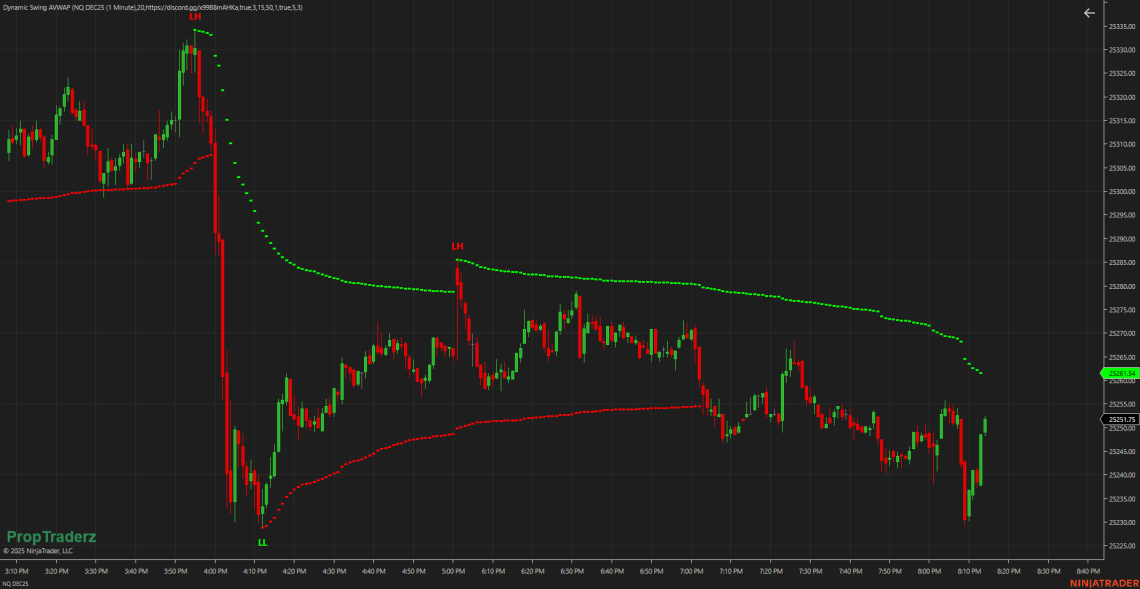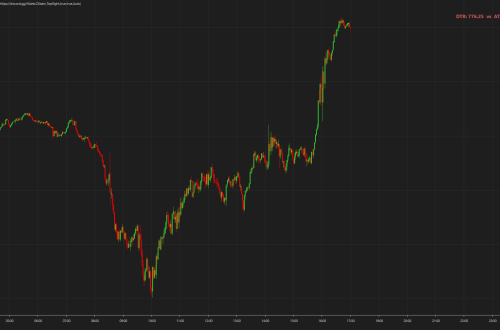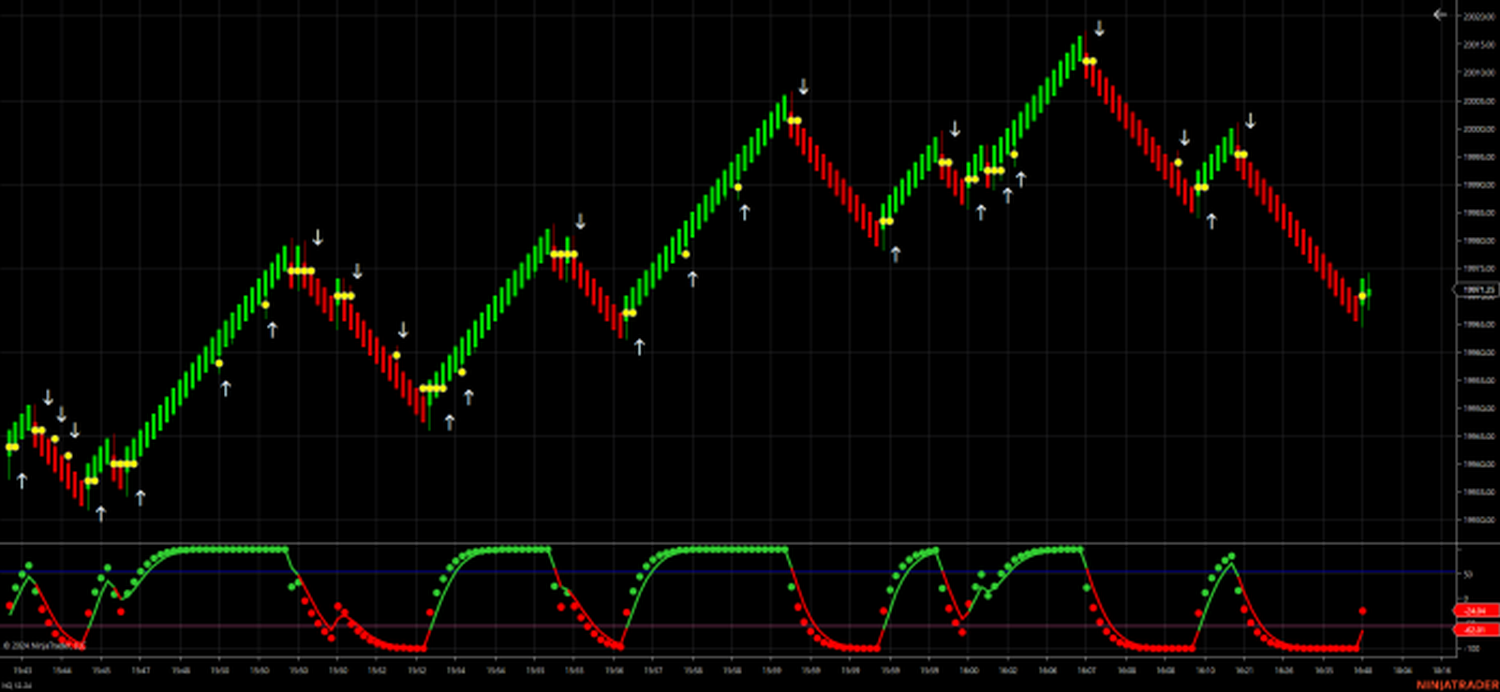D
Indicators starting with D
-
Dynamic Swing Anchored VWAP
The Idea – Dynamic Swing Anchored VWAP Markets move in legs, not straight lines. Every leg begins where the previous one failed — at a pivot. The Dynamic Swing Anchored VWAP maps that structure directly on your chart by resetting a VWAP (Volume-Weighted Average Price) from each confirmed swing high or swing low. Instead of a single running VWAP that smears trend changes, this version anchors locally — one calculation per leg — letting you see where real accumulation and distribution happen. It’s like watching institutions reload each swing. How It Works Each time price forms a new pivot (HH, HL, LH, LL), the indicator: Detects the swing using your…
-
DTR vs ATR – The One-Line Volatility
📈 DTR vs ATR – The One-Line Volatility What is it? DTR vs ATR– The One-Line Volatilit is a simple yet powerful indicator developed by PropTraderz, now available on NinjaTrader 8, originally inspired by @Ripster in TradingView. This tool overlays a clean, color-coded label on your chart that compares: IMPORTANT : LOAD AT LEAST 14 DAYS OF DATA ON YOUR CHART 📊 DTR – Daily Trading Range: How far price has actually moved so far today. 🧮 ATR – Average True Range: How far the instrument usually moves in a day, averaged over the last 14 sessions (or your preferred lookback). Together, it gives you a live, percentage-based readout of…
-
Dual Trend Indicator
DualTrendIndicator How to Use the Dual Trend Indicator The Dual Trend Indicator helps you identify potential trading opportunities by combining momentum analysis with trend detection. It is designed to work effectively on both Renko bars and time-based charts by allowing you to switch between parameter sets optimized for each chart type. Importance of Different Parameters for Chart Types: Renko Bars: Characteristics: Renko charts filter out minor price movements and focus on significant price changes, creating bricks of equal size. This results in smoother trends and clearer signals. Parameters: The default parameters for Renko charts are optimized to account for the reduced noise and different scaling inherent in Renko bars. Time-Based Charts:…
-
Double LSMA
Double LSMA Introducing the Double LSMA Slope Indicator by PropTraderz First, what is LSMA? The Double LSMA indicator is an advanced technical analysis tool that takes trend analysis to a new level, using dual Least Squares Moving Averages (LSMA) to identify market momentum over different timeframes simultaneously. It is calculated using the least-squares regression analysis method, which involves finding the line of best fit through a set of price data points. This line is then used to calculate the moving average, which provides traders with an indication of the direction of the trend. Compared to other moving averages, LSMA is considered more responsive to changes in price trends and less…
-
dp QGP Channels
dpQGP- QGPair. It is now a pair of channels, fast (Trend1 and Trend2) and slow (Trend3 and Trend4), and as price moves around those channels, signals are generated. Everything is available for your tweaking: channel coloring, signal type/color/size, channel upper and lower parameters. In the Properties, there is a property named ‘ContinuationSignals’ and it has a numeric input. That number is the number of bars allowed between price falling below Trend1 and rising back above it for long signals, or price rising above Trend1 and then falling back below Trend1 for short signals. It will become clear when you see it on your chart. There is a Toggle on the…
-
DynamicSRLines
This indicator draws horizontal Support/Resistance lines at various price levels, above and below the market, where price historically created swing High/Low pivots multiple times, creating support and resistance as price action bounced off of those levels. Created By NinjaTrader_JoshG NinjaTrader Version 8 File Size 3.2 KB Create Date 01/19/2018 # of Downloads 8344 and counting
-
DR/IDR/FVG/ORB- Defining Range and Volume Indicators
DR/IDR levels for NinjaTrader 8 DR/IDR levels are used in trading as key price levels for determining entry and exit points, as well as for setting stop-loss orders. Traders often use technical analysis techniques to identify these levels, such as support and resistance levels, trend lines, and chart patterns. For example, a trader may observe that a DR/IDR tends to find support at a certain price level, and therefore set a stop-loss order just below that level to minimize potential losses. Alternatively, a trader may look for a breakout above a key resistance level to signal a potential entry point into a long position. It’s important to note that using…









